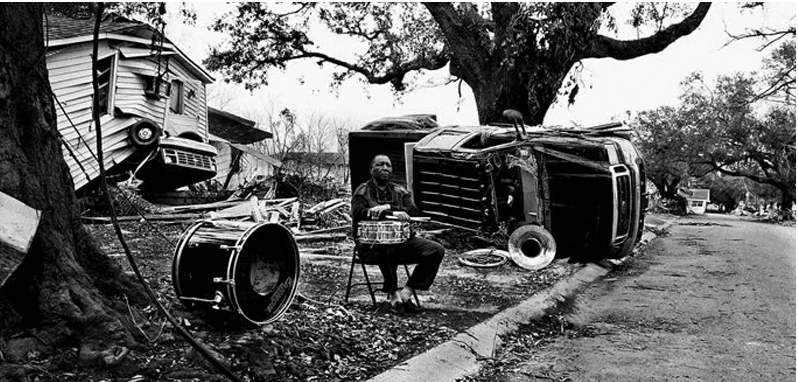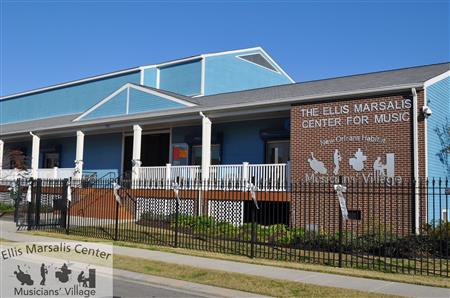 |
| Hurricane Katrina causing severe devastation (https://ellismarsaliscenter.org/musicians-village) |
Mahatma Ghandi states, "You must be the change you want to see in the world". Jim Pate followed his heart to change the world and gave hope to the devastated people of New Orleans. Prior to his volunteer work, Jim followed his parents into taking a more "traditional" career path. After graduating from Emory College in 1971 with a Bachelor's Degree in Psychology, Jim received a Juries degree from the University of Tennessee. While practicing law, he became resentful of lawyers since they were "pursuing money rather than justice" ("Jim's Open Road"). He left law, volunteered through his church, and joined Habitat for Humanity (Habitat) in 1984. Habitat is a non-profit organization to build houses for impoverished and inadequately housed people. Jim was successful in the Dallas affiliate, in the International Jimmy Carter Work Project, before being recruited by the New Orleans affiliate. Heroes must possess care for people in need and perseverance to make a positive change through selfless dedication to support a higher cause with what they know. Caring is displaying genuine kindness and concern for others. Heroes are selflessly dedicated, wholeheartedly giving themselves to help others in need. To successfully make a change, you will face problems and you will need perseverance and must be determined to get over challenges and fight to achieve success. Jim Pate utilized his law degree and years of building project management experience to lead the largest rebuilding effort in Habitat for Humanity's history; he is an inspiration because of his caring nature to help others in need, selfless dedication working longer than others, and perseverance to rebuild New Orleans.
Jim is an inspiration because of his caring nature which has led him to wholeheartedly help others in need through his involvement of Witnesses for Peace and in Habitat for Humanity. He gave up his law practice to pursue a higher cause and began volunteering for various jobs. "In the 1980's, Pate went to Central America as part of a Witness for Peace, an activist organization founded in 1983 to document the effects of US foreign policy in Latin America. During the conflict in Nicaragua between the right-wing Contras and the socialists Sandinistas, he was grazed by a bullet in his pinky finger, leaving a small scar" (Megerian 2007 p.13). The Reagan administration supported the Contras during the conflict in Nicaragua. Concerned for people who suffered during the Nicaraguan Civil War, Jim decided to help by joining the Witnesses for Peace and accompanying the Nicaraguan people in the war zone to film suffering to raise awareness and further the goal of peace. Led by faith and conscience, Jim put himself in harm's way to demonstrate his commitment to nonviolent ways to support peace and justice. Pate wanted to assist people who are impoverished and inadequately housed, so he left law and devoted himself to Habitat for Humanity. "Twelve days after the storm hit, Pate drove back to New Orleans, which was still under 8 feet of water and martial law. He spent his days assessing storm damage in the city and his nights two hours away in a hotel in Jackson, Miss" (Megerian 2007 p.12). Hurricane Katrina hit New Orleans on August 29, 2005. Water spilled over a levee along the Inner Harbor Navigational Canal, which flooded almost the whole city. In the aftermath of the storm there were 1,500 killed, 3/4 were evacuated, and 300,000 uninhabitable homes. While everyone else evacuated, Jim returned because he knew there was going to be a lot of work to rebuild "The Big Easy ". Jim has shown caring through his actions to help others in a civil war and a natural disaster, going far past the ordinary to demonstrate exceptional acts of heroism.
 |
| Jim Pate, Executive Director (http://www.bizneworleans.com/Biz-The-Magazine/August-2015/A-Healthy-Habitat) |
Jim is a hero because he is selflessly dedicated to the task of rebuilding New Orleans and was willing to sacrifice personal comforts and work more hours than anyone else. Hurricane Katrina was the deadliest and most destructive hurricane since 1928. The city's infrastructure was destroyed and residents were evacuated. "The city where he had lived for five years had become an alien wasteland...Nor was there power or running water. Pate ate canned food and military-issued meals for two months while he waited for the government to restore basic services" (Megerian 2007 pg. 12). Jim was committed to his mission to provide affordable housing and to help the city recover. He shows his endurance in this part, too, even though everyone else had evacuated. He suffered the rough conditions so he could stay to continue making assessments and plan to resurrect the community. Before the storm, the Habitat affiliate was only constructing about 10 houses every year; in contrast, Jim had expected to see the construction of 250 homes by 2007. "Although many Habitat staff members work six days a week, Pate is viewed as a special kind of workaholic" (Megerian 2007 p.13). According to Bob Marye, Habitat Development and Church Relations Coordinator, "All of us look at him and worry about him burning both sides of the candle and lighting the middle...There's not a person here who wouldn't jump between Jim and a bullet" (Megerian 2007 p.13). Jim shows his devotion in this quote because he stays to do his work longer than anyone else. He invests many hours of his personal time "burning both sides of the candle" because there is so much work to be accomplished in a short amount of time. He needs to orchestrate cleaning, arranging delivery of materials, working through bureaucracy, and coordinating many volunteers who have no construction experience. These examples demonstrate that Jim is selflessly dedicated by showing his willingness to endure and suffer the harsh conditions of post-Katrina New Orleans for 2 months without water or electricity, where he stayed after working almost nonstop to rebuild the devastated city.
Jim's perseverance helping him stay positive and pushing him to get past the difficult challenges of rebuilding New Orleans and to achieve success. To meet the goal of building 50 homes by Christmas 2006, a large number of inexperience volunteers have visited to help. Jim told interviewer from the National Building Museum, "In the first few weeks, the devastation was so vast and despair was so widespread, that it was difficult to even imagine recovery. But, the outpouring of generous support and the many volunteers willing to help stirred our hope" ("Civic Innovator: New Orleans Habitat Musicians' Village"). This quote shows the frustration and challenges and that there seems to be no hope to recover but Jim finds positive motivation from the supporters and volunteers. With hope, Jim keep building because nothing like this has ever happened before and they have to keep rebuilding New Orleans. Beside not having basic services, the destruction of Hurricane Katrina left the Habitat affiliate with no vehicles and tools. This presented many great challenges and difficulties that Jim would face. "Driving through the city one day, he found a restaurant that had managed to reopen by routing electricity from a nearby National Guard camp. He grabbed his laptop and wireless card, and for two months Habitat for Humanity's New Orleans office was headquartered in Fat Harry's Bar and Grill...The menu had two items: ham on white bread and turkey on white bread. But the owner soon doubled his offerings by adding a cheese option to both sandwiches" (Megerian 2007 page 12). Using Fat Harry's Bar and Grill as temporary office, Jim stayed the course of coordinating the Habitat's efforts to rebuild the community as quick as possible and he did not wavered by the lack of basic services and lost resources. The owner of Fat Harry's Bar and Grill witnessed how Jim was determined to help the community and recognized Jim's contribution by adding cheese option to his sandwiches. Perseverance is what makes a hero special. Jim do not give up and he continued in the course of action to rehabilitate those who were displaced.
 |
| Ellis Marsalis Center for Music (https://ellismarsaliscenter.org/photo-galleries) |
Jim Pate is an inspiration because he is caring to help others in need. He exemplified selfless dedication by sacrificing personal comforts and work more hours than anyone else to lead the Habitat staff and volunteers. Nine years after Hurricane Katrina, Jim's perseverance had eventually helped Habitat make it's 500th home build. Jim did not follow the traditional career path, he quit law to use his skills and experiences to make changes he wants to see by being the Architect of New Orleans.
"Reflecting on Nine Years of Rebuilding." Blog post. New Orleans Area Habitat for Humanity. N.p., 29 Aug. 2014. Web. 02 May 2017. <http://www.habitat-nola.org/reflecting-on-nine-years-of-rebuilding>.
Http://www.sej.org/sites/default/files/JPate.pdf. N.p., n.d. Web. Megerian, Chris. "The Architect of New Orleans." Mar. 2007: n. pag. Web.
"Civic Innovator: New Orleans Habitat Musicians' Village." N.p., 16 Feb. 2010. Web. <http://nbm.rog/category/blog>.
"A Healthy Habitat." A Healthy Habitat. Biz The Magazine, Aug. 2015. Web. 02 May 2017. <http://www.bizneworleans.com/Biz-The-Magazine/August-2015/A-Healthy-Habitat>.
Megerian, Chris. "The Long Road Back to New Orleans." The Emory Wheel, 14 Nov. 2006. Web.
"Jim's Open Road." Jim Pate | Roadtrip Nation. Road Trip Nation, n.d. Web. 04 May 2017.
<http://roadtripnation.com/leader/jim-pate>.Page created on 5/22/2017 12:00:00 AM
Last edited 5/22/2017 12:00:00 AM
